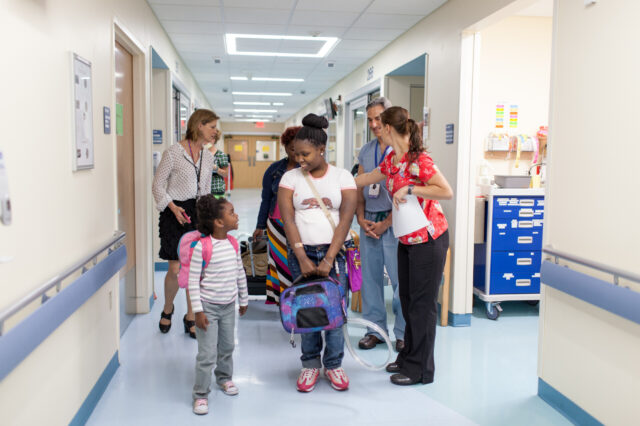Sanford teen leaves hospital with temporary artificial heart and portable driver

A 16-year-old Florida girl is the youngest person in the world to leave and spend the night outside of a hospital with a temporary artificial heart and portable driver today (April 18).
Nalexia “Lexi” Henderson, who was the first patient in Florida to receive the SynCardia temporary Total Artificial Heart and the accompanying Freedom Portable Driver, left UF Health Shands Children’s Hospital just in time to celebrate Easter and her 17th birthday.
“Our team has worked hard to allow her a safe and healthy discharge,” said Mark Bleiweis, M.D., Lexi’s cardiothoracic surgeon and director of the UF Health Congenital Heart Center. “We, including Lexi and her family, have worked to get everything in place for Lexi to be able to wait for her heart transplant outside the confines of the hospital.”
Henderson said that she is excited to be out of the hospital in time for her birthday.
“There is so much more I'd like to do for my birthday but I'm really happy my family will be gathering together,” she said.
When Henderson arrived at UF Health Shands Children’s Hospital almost a year ago in mid-May, she was in severe heart failure. Her transplanted heart, which she had received in 2007 at UF Health Shands Hospital, could no longer pump enough blood throughout her body to keep other organs functioning. Her body was shutting down.
She was diagnosed with severe cardiac allograft vasculopathy, a condition in which the coronary arteries are severely damaged by risk factors associated with a heart transplant. At first, her cardiac care team tried using extracorporeal membrane oxygenation, or ECMO, a method of providing cardiac and respiratory support to patients whose heart and lungs can no longer function.
“Lexi was clearly in shock; she was really sick,” Bleiweis said. “We supported her with ECMO for a short period, but her previous transplant was failing. She was in deep trouble, with multiorgan dysfunction.”
While UF Health offers pediatric and adult cardiac patients a variety of ventricular assist devices, the primary devices for children are the SynCardia temporary Total Artificial Heart and the Berlin Heart. In 2006, UF Health Shands was the first in Florida to use the Berlin Heart, an external device specifically designed for children that connects to the patient’s own heart.
The SynCardia heart was a better choice for Lexi, who is nearly adult-sized, because it is a larger device and can pump more blood than the Berlin Heart.
Without devices like the SynCardia heart, there are limited options, Bleiweis said.
“We choose a machine to help the heart because we feel medication alone won’t be enough for them to survive until transplant,” he said. “With the SynCardia heart, Lexi’s other organs have completely recovered. She’s now an excellent candidate for transplant.”
In early June last year, UF Health surgeons removed Henderson’s own failing atria and ventricles and implanted the temporary total artificial heart, which initially was powered by an external machine nicknamed “Big Blue.” At 418 pounds and the size of a washing machine, Big Blue provides pneumatic power to the heart, but it isn’t conducive to patient mobility.
On Dec. 9, Henderson was switched to the portable driver, which is undergoing a Food and Drug Administration investigational device exemption clinical study in the United States.
“It was a little scary at first, but it was a good thing,” Henderson said. “I feel like my normal self. There’s nothing bad about the SynCardia heart; you got life.”
The SynCardia temporary Total Artificial Heart is the only approved mechanical device that eliminates the symptoms and source of heart failure. The Freedom Driver is a portable, pneumatic machine that powers the artificial heart.
UF Health Shands Hospital is the first and only SynCardia certified center in Florida.
Fact Sheet
- April 18, 2014: Lexi is discharged to transplant housing, making her the youngest patient in the world to be discharged from the hospital simultaneously using the SynCardia and Freedom Driver.
- Nov. 20, 2013: Nalexia “Lexi” Henderson is transferred from the 418-pound “Big Blue” external device to the Freedom Portable Driver, a 13½-pound, backpack-sized power supply for the SynCardia heart. Lexi is the youngest patient in the world to simultaneously use the SynCardia with the Freedom Driver.
- June 3, 2013: UF Health became the first pediatric heart center in Florida to use the SynCardia temporary Total Artificial Heart.
Facts about the UF Health Congenital Heart Center:
- Ranked by U.S. News & World Report as one of the Top 50 pediatric cardiology and heart surgery programs in the country;
- Opened new 18,000-square-foot pediatric cardiac intensive care unit that includes 22 private patient rooms, each with its own bathroom and shower; rooms also feature ceiling-mounted exam lights, ceiling-mounted patient-lifting systems and a kid-friendly gaming station and television. Each room also has a nurse’s alcove in the corridor with state-of-the-art monitoring systems for patient observation.
- Only center in North Florida region that has experts specializing in cardiac care for unborn babies, newborns (including premature and low-birth-weight babies), children, adolescents and adults
- UF Health and its Congenital Heart Center are the first in Florida to perform:
- 1986: pediatric heart transplant
- 1993: infant heart transplant
- 1999: pediatric heart/lung transplant
- 2006: Berlin Heart implant as bridge to transplant
- 2013: heart/lung transplant in youngest infant
- 2013: SynCardia Total Artificial Heart implant as bridge to transplant
SynCardia resources:
- Multi-media: www.syncardia.com/media/multimedia-library-dp1.html
For media inquiries, call Rossana Passaniti at 352-273-8569 or email passar@shands.ufl.edu.